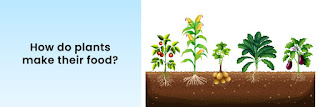Photosynthesis Meaning and Definition
Photosynthesis is the process through which plants produce their food. Light is represented by photo, and synthesis is the process of putting things together.
As a result, chlorophyll aids plants in utilising light in conjunction with other resources to produce food. They make use of the following resources:
Water
Carbon Dioxide
Sunlight
Water : When we water plants, the water is absorbed via the soil by the roots. The roots aid in the distribution of water to the leaves via the stem. Veins are thin lines that run through the leaves. They assist in the transportation of water to various portions of the facility.
Carbon dioxide : We inhale oxygen from the air and release carbon dioxide when we breathe. This carbon dioxide is absorbed by the plant's leaves via stomata. Stomata are the microscopic pores beneath the leaves' surface. These pores aid in the exchange of gases and the removal of excess water from the plant by the leaves. The pores are so minuscule that they can't be seen with the naked eye.
Sunlight : Chlorophyll in the leaves retains the sun's energy. This energy allows plants to convert water and carbon dioxide into glucose, a type of sugar. Through the veins in the leaves, this glucose is transferred to various regions of the plant.
Check other science notes
Tag - Photosynthesis Process; importance of photosynthesis; chlorophyll in plants; school online class; online class 4 science

Comments
Post a Comment
Thank you we will contact ASAP.